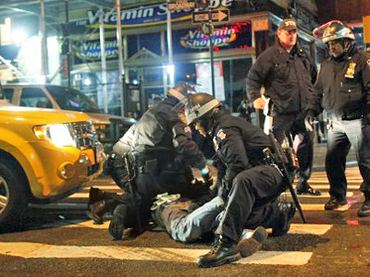

| Visitors Now: | |
| Total Visits: | |
| Total Stories: |

| Story Views | |
| Now: | |
| Last Hour: | |
| Last 24 Hours: | |
| Total: | |
Police Using ‘Predictive Analytics’ To Prevent Crimes Before They Happen
Crime fighters have long used brains and brawn, but now a new kind of technology known as “predictive policing” promises to make them more efficient.
A growing number of law enforcement agencies, in the US and elsewhere, have been adopting software tools with predictive analytics, based on algorithms that aim to predict crimes before they happen.
The concept sounds like something out of science fiction and the thriller “Minority Report” based on a Philip K. Dick story.
Without some of the sci-fi gimmickry, police departments from Santa Cruz, California, to Memphis, Tennessee, and law enforcement agencies from Poland to Britain have adopted these new techniques.
The premise is simple: criminals follow patterns, and with software — the same kind that retailers like Wal-Mart and Amazon use to determine consumer purchasing trends — police can determine where the next crime will occur and sometimes prevent it.
Colleen McCue, a behavioral scientist at GeoEye, a firm that works with US Homeland Security and local law enforcement on predictive analytics, said studying criminal behavior was not that different from examining other types of behavior like shopping.
“People are creatures of habit,” she said.
“When you go shopping you go to a place where they have the things you’re looking for… the criminal wants to go where he will be successful also.”
She said the technology could help in cities where tight budgets were forcing patrol reductions.
“When police departments are laying more sworn personnel, they can do more with less,” she said.
The key to success in predictive policing is getting as much data as possible to determine patterns. This can be especially useful in property crimes like auto theft and burglary, where patterns can be detected.
“You can build a model that factors in attributes like the time of year, whether it is hot and humid or cold and snowy, if it is a payday when people are carrying a lot of cash,” says Mark Cleverly, who heads the IBM unit for predictive crime analytics.
“It’s not saying a crime will occur at a particular time and place, no one can do that. But it can say you can expect a wave of vehicle thefts based one everything we know.”
IBM has worked with dozens of agencies such as London’s Metropolitan Police, the Polish National Police and a number of US and Canadian cities.
In Memphis, officials said serious crimes fell 30 percent and violent crimes declined 15 percent since implementing predictive analytics in a program with IBM and the University of Memphis in 2006.



